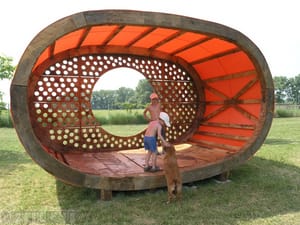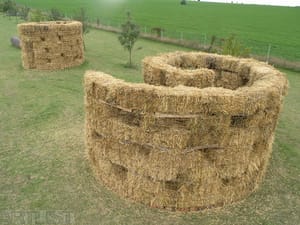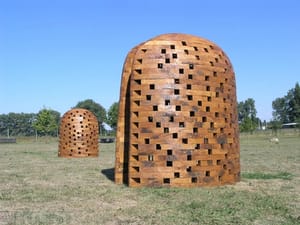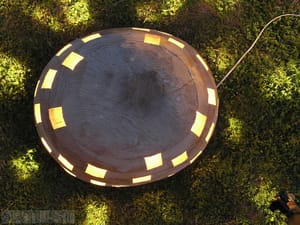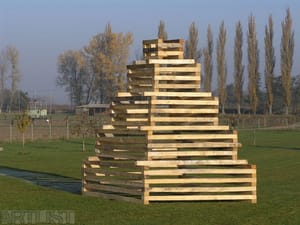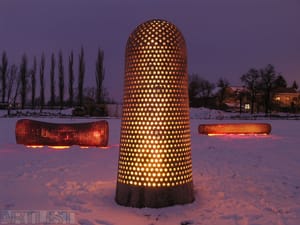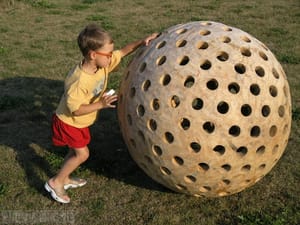- First Name
- Miloslav
- Surname
- Fekar
- Born
- 1973
- Birth place
- Hranice na Moravě
- Place of work
- Bezměrov u Kroměříže
- Website
- www.fekar.com/milos
- Keywords
- CSU Library
- ↳ Find in the catalogue
About artist
Miloslav Fekar creates monumental wooden sculptures for the outdoors. Because of his highly pared down sculptural language he is often classified as a post-minimalist (in the Czech Republic another such example would be Jan Ambrůz, Fekar’s compatriot).
Fekar studied sculpture at the Academy of Fine Arts (AVU), Prague, and at the Faculty of Fine Arts (FaVU), Brno (with Professor Demartini and Professor Preclík), and very soon took an interest in the creation of sculptures as a reaction to a specific environment (from 1992 he executed private events in the countryside, which only exist today in the form of photographs). From the very start it was clear that his creative work would be decided by personal physical experience of space and landscape.
Fekar’s monumental sculptures can be divided roughly into two categories: organically conceived sculpture based on free natural morphology (e.g. Shell, Eggshell), and architectural sculptures which are characterised by geometric shapes and a constructional, often variable principle (e.g. Little Temple, Gazebo, Little Building). However, this classification is not absolute, and there exist clear overlaps between both groups. For instance, biomorphic sculptures may have an architectural quality, i.e. they are works which can be entered (Box for Two), while geometric constructions acknowledge the handiwork that has gone into them and their tactile quality invites them to be touched and occupied.
Fekar frequently conceives his work in terms of long-term projects, a fact which bears witness to the depth of his search and the systematic approach he adopts to the topics chosen. The project entitled Wandering (from 1999) represents a set of wooden objects the artist calls “spatially variable structures”, which have a wandering character – they can be relocated, supplemented and adapted (Stromovka Park, The Borders with Moravia, Kroměříž). They are characterised by openness toward space and time. Though Fekar’s work bears a certain resemblance to land art, it differs from that movement in that it is always deliberately located in cultural landscapes (parks), with which it holds a dialogue (references to the archetypal forms of gazebos). Fekar’s project Sculpture Orchard is closer to land art. Over a surface area of 7,500m2 the piece investigates the impact of his objects, which he has sometimes described as “sarcophagi of human feelings”, on the open landscape and in time.
In 2001 Fekar began to create slotted wooden organic objects in which he placed a light (Shells). The viewer’s interest is thus taken from the surface of the sculpture into its interior: the sculpture evokes the secret of creation or may be bearing witness to an almost magical emanation of substance. As Exupéry says: “What is essential is invisible to the eye”. Sometimes Fekar hangs his slotted objects in the crowns of trees, which lends them a new, almost cosmic significance. He is interested in their fluid activity in time, over a day, a year. He documents everything in colour photography, which means the conceptual continuation of his creative work.
For a sculpture an important moment is when the sculpture comes alive, i.e. when people touch it, enter it, explore it. From whence it was simply a small step to sculptures applied in utility production (designs for park furniture, the Sluňákov Ecology Centre, detached houses and gardens, etc.).
- Author of the annotation
- Kateřina Pietrasová
- Published
- 2009
CV
Studies:
1996-2000 DAMU in Prague, stage design, Miroslav Melena , Pavel Kalfus
1996-1998 Faculty of fine arts, Brno Technical University in Brno, department of sculpture, Vladimír Preclík
1992-1996 Academy of fine arts in Prague, department of sculpture, Hugo Demartini, Jan Hendrych, Jindřich Zeithamml
1988-1992 Secondary school of applied arts in Uherské Hradiště, department of painting
Awards and stipends:
2004 Grant Pollock-Krasner Foundation, New York, USA
2000 Grant Pollock-Krasner Foundation, New York, USA
Exhibitions
- Solo exhibitions
-
2008
Galerie Ceasar, Olomouc (perforated objects, sculptures)
2007
Zámek, Hranice (squares - 2 objects)
Klub Divadla 29, Pardubice (Metamorphoses of a Sculpture Park - photographs)
2003
Náměstí, Zlín (form and light - 10 objects)
2002
Zámek, Hranice (form and light - 23 objects)
2001
Podzamecká zahrada, Muzeum a skleník Květné zahrady, Kroměříž (Wandering - 15 objects)
2000
Valy a sklepení východočeské galerie, Pardubice ( Wandering - 12 objects)
Synagoga, Hranice (Wandering - open conches)
Bývalý kostel sv. Václava, Opava (Heaven on the Earth)
1999
Park Stromovka, Praha (Wandering - 16 objects)
- Group exhibitions not included in ARTLIST.
-
2008
Vltava 2008, Praha (construction on the embankment)
Kateřinské zahrady, Praha (nothing to admire)
2006
Zapadočeské muzeum, Plzeň (festival of tea and other cultures)
Konstancin - Jeziorna, Polsko (exhibition of twin cities)
2005
Zámek, Stará radnice, Hranice (exhibition of twin cities)
Voorburg, Holandsko (exhibition of twin cities)
Reduta, Uherské Hradiště (Sculptors05, at the film school)
Muzeum, Plzeň (Ten Positions of the Comtemporary Olomouc Art Scene)
2004
Hypovereinsbank-Atrium, Berlin (Seven Sculptors from the Zlín Region)
2003
Únětice, Praha (Time of Enlightment)
Národní galerie, Veletržní palác, Praha (The Youngest Ones)
Muzeum, Kroměříž (Sculptors of the Zlín Region I)
2002
Sýpka, Klenová (The Wilderness - Nature, Soul, Language)
Plauen, Německo (Strasse der skulpuren)
komplex Slovanský dům, Praha (Living Space)
Galerie Navratil, Praha (Sculptura Association)
2001
Valtice - Velký formát (Night Pictures)
Přední Kopanina (Symposium - Plaener Shells)
Muzeum, Uh.Hradiště (Comebacks III)
2000
Rezidence Čimelice (Conches, Heaven on the Earth)
Lázně Bludov (Objects)
hrad Sovinec (Objects)
Erlbach, Německo (16-2)
1999
Rezidence Art-Omi stát New York, USA (Conches - Family)
Galerie AVU, Praze (Conches)
Demolice-4+4dny v pohybu, Praha (4 times 12)
1998
Rezidence Plasy (Crystal)
Olomouc (Pillar)
1997
Kaämkapää, Finsko (Granite Symposium - Meeting of Three Circles)
1996
Králíky (Symposium - Pillars and Entablature, Variable Case)
1994
hrad Helfštýn (Division of Eternityi)
- Other realisations
2007 objects for the Chateau Park, Hranice in Moravia
2007 objects for the Orio building in Ostrava
2005 object for the city of Voorburg vin Holland
reconstruction of a family house in Bezměrov (2003-09)
family house, Bezměrov (2009)
Hradisko - Kroměříž (2008)
Sítenské Valley Park , Kladno (2006)
Entablature for a private garden in Prague-Nusle (2006)
Wood Fancing for a Playground, Kroměříž (2005-6)
Waste Dump Recultivation, Kroměříž (2005)
Stone Fancing for a Playground, Kroměříž (2005)
park benches, Zlín (2005)
private garden in Prague-Černošice (2005)
objects for a private garden, Kroměříž (2003)
portals and gates, family house at Hrubá Skála (1998-2001)
Stromovka Park, Prague (1994-99)
Sate Design
2009 Dámská šatna, Studio Dva Praha (stage design)
2009 Ideální manžel, Národní divadlo Brno (stage design)
2008 Mein Faust, Slováckém divadle v Uherském Hradišti (stage design)
2007 Villon F. (Na krk oprátku ti věší) ve Slováckém divadle v Uherském Hradišti (stage design and animation)
Monography
- Monography
MEDIA
Kultura.cz, Czech TV, Channel 2 - Miloslav Fekar´s portrait
Bydlení je hra, Czech TV, Channel 1 – Miloslav and Petra Fekars
Náš venkov, Czech TV, Channel 2 – Touha po prostoru (Longing for Space)
- Other critical texts
Osobnosti české architektury, Agentura Kdo je kdo, Praha 2003
Nejmladší, NG Veletržní palác, Praha 2003
Osobnosti české současnosti, Agentura Kdo je kdo, Praha 2002
Strasse der Skulpturen, Plauen 2002
Sochařské sympozium Přední Kopanina 2001, Ledoborec, Praha 2001
Moderní socha v Praze , Agentura Kdo je kdo, Praha 2000
Grand Prix obce architektů , Architekt , a.f.BKK, Praha 2000
Sochařské sympozium Sloup 98 , Galerie Caesar , Sprint Olomouc 1998
Slovník českych a slovenských výtvarných umělců 1950-98, Výtvarné centrum Chagall , Ostrava 1998
Demartini - Sochářská škola II , Galerie Medium , Orman , Bratislava 1993
